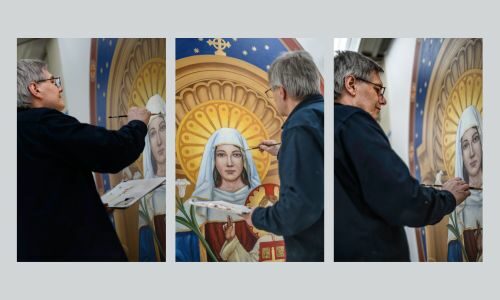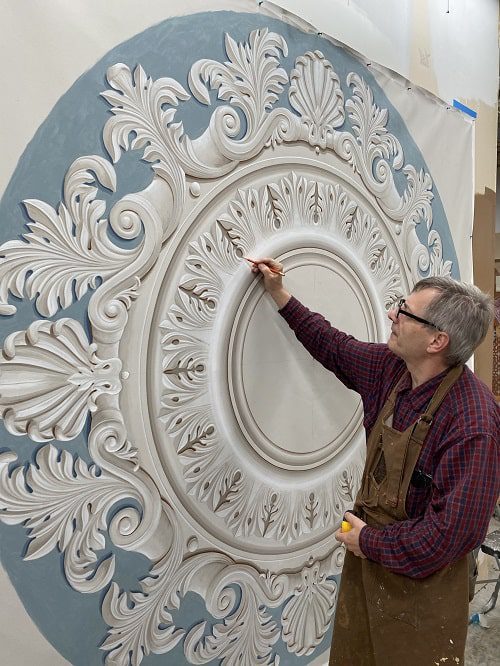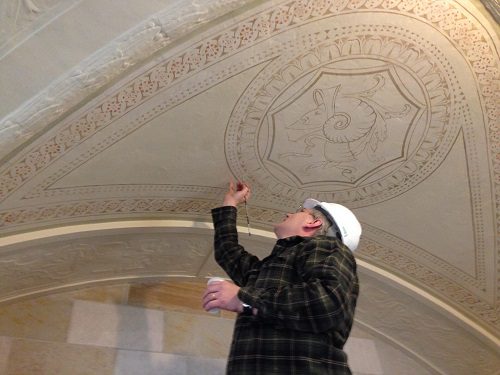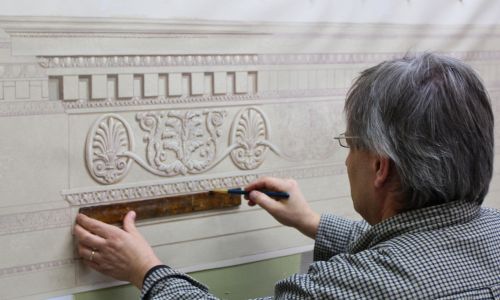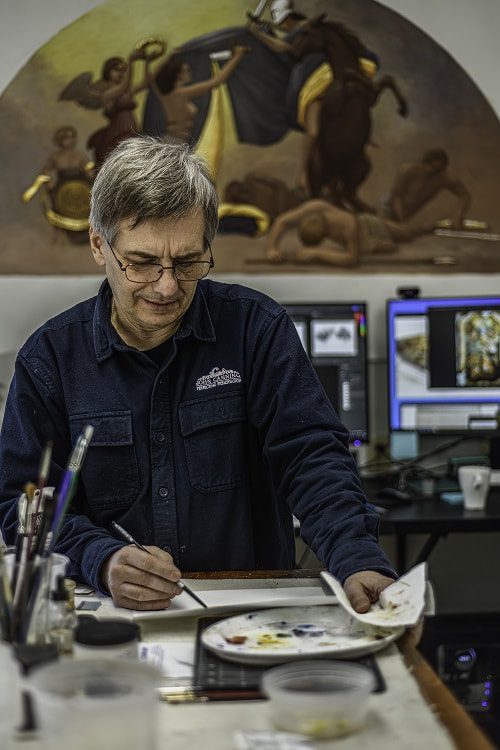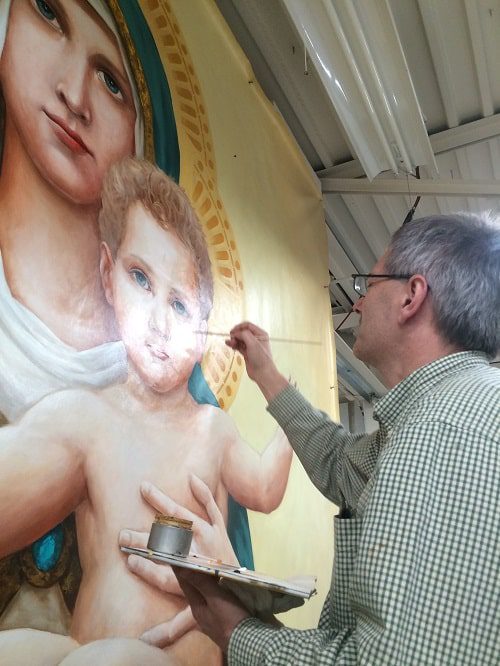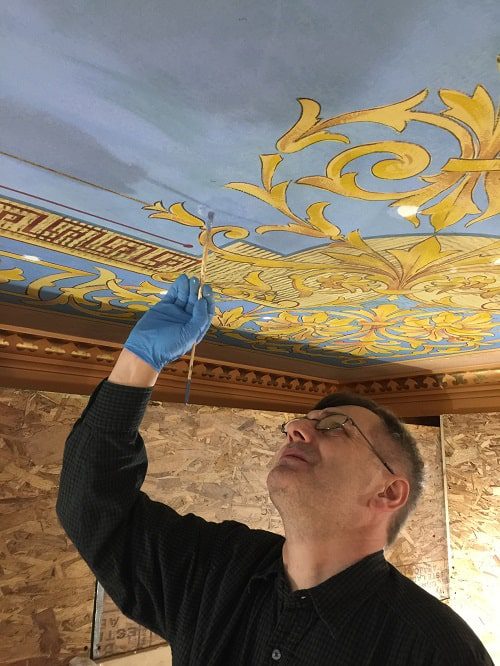John Canning & Co.'s Team Spotlight
Piotr Wirkijowski
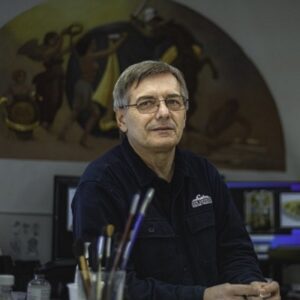
John Canning & Co. is proud to spotlight our Director of Art, Piotr Wirkijowski. Joining the company in 2008 – he has dedicated 15 years with Canning thus far in the historical decorative paint restoration, conservation, and preservation space. As a Director of Art, Piotr is a well-seasoned and highly skilled artist in our studio – designing and producing renderings, commissioned artwork, and murals to name a few. Read more to learn about Piotr, his typical day, and portfolio of work.
How did you get started in the field?
Back In the nineties, a year after I immigrated to America, I had an opportunity to be on a team that restored a fire-damaged church. Once the decorative restoration was complete, the pastor asked me to paint a few more murals. Painting big scale was something I really enjoyed and still do to this day.
At the completion of the project, I started to look for a company where I could utilize and further develop my artistic and decorative skills – a Catholic Directory Book happened to have an advertisement for John Canning & Company. Long before using Google to search a company and their accolades, I had to drive from New Jersey to Connecticut to see the company in-person. Then and now, the impression on me of their work quality and professionalism ignited my adventure with big scale art and decorations – one that continues today.
(Left) In studio creating decoration for First Church of Christ Woodbridge. (Right) Conservation of artwork at Yale University’s Sterling Memorial Library
What does a typical day look like?
It depends what project is assigned; not every day is the same. For example, if we work for a church - first thing we do is discuss design, color palette, and, scope of work, then we review and schedule how to manage the work, noting what decorative art is installed first. When installing artwork and murals in the field we look closely at the building dimensions and specific measurements to ensure that the canvased artwork will fit appropriately in the space. We are always thinking and talking about lighting and how it will affect color and art. When working in the field there is more hands-on work ranging from the application of various decorative techniques - marbleizing, wood graining, stenciling, gilding – to providing artistic skills for a mural. At the end of the day, we review the progress and art - how it relates to the architecture and lighting.
When in the studio I collaborate with other design members and we develop stencils, stencil patterns, interior color schemes, renderings, and development of mural subject matter. My expertise and design skills are required for new stencil designs, murals, or interior color scheme development. We always look at the work and quality to ensure the art pieces we create have an appearance that they were a part of the original architecture. Studio objectives we focus a great deal on is any artwork or decoration that is developed for a specific project will have the appearance of being part of the architectural design and intent, even if it has been installed decades later.
(Left) Piotr develops a stencil design using tools of the trade and over a decade of industry knowledge. (Right) Piotr in studio developing various renderings.
Do you have any favorite projects you’ve worked on?
A few, West Virginia State Capitol - Designed by famous architect Cass Gilbert; dedicated in June 20 1932. Since the dedication, the decorations and murals of the lunettes and pendentives in the rotunda remained incomplete. In 2010 John Canning & Company was invited to bid on 4 lunettes and 4 pendentives - decorations and murals - in the rotunda. As part of the design composition, we prepared large-scale renderings of possible subject matter and style that were enthusiastically received by the Committee, and ultimately lead to being awarded the project. Two more notable projects I am proud to have worked on are St. Patrick Cathedral – Norwich, CT which featured the commissioned reproduction of 22 fine art murals based on historic photos and a series of simulated stained glass windows. The St. John Basilica – Stamford, CT project required the reproduction of original art and color scheme featuring artwork, trompe l’oeil, and grisaille of four Saint figures within the nave which was produced on canvas.
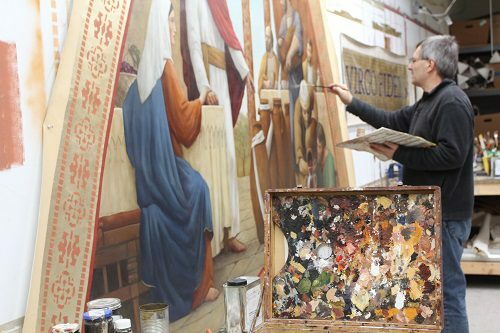
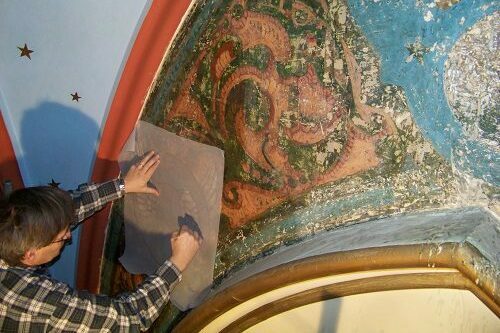
(Left) Piotr working on mural for St. Patrick Cathedral in studio. (Right) Piotr working on the Basilica of Saint John the Evangelist project.
What is your favorite part of your job?
When the work is complete - getting our client’s positive reaction and appreciation put into it is worth all the hard work and dedication. To me. This is an accomplishment and is my favorite part of my job.
(Left) Mural of Mother Mary and Baby Jesus - St. Mary Church, Willimantic, CT (Right) Decorative ceiling paint for Michigan State Capitol.
Describe your design process – What advice do you have for someone interested in the decorative arts?
My design process is 100% based on the client needs and scope of work. The initial meeting is to gather information by walking through the project space to identify areas needing restoration, preservation, or conservation. From the initial meeting I begin to prepare conceptual visualizations for presentation to the client. This process is turned over until the client is satisfied with the final design. For someone looking to enter the decorative arts field, be familiar with decorative techniques like marbling, woodgraining, stenciling, and gilding skills that are most commonly needed. It is also important to have an understanding of nature in color for interior spaces and what the phrase “decorative art should follow architecture” means.
